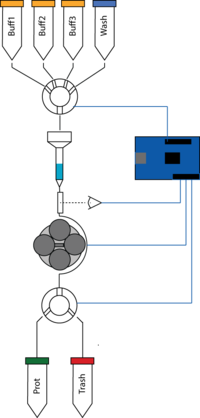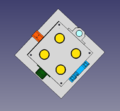APPS
Objective and context
In laboratory, routine tagged-protein (His or strep tagged proteins) purification is usually made manually with the the help of resins. This procedure is often, so to say, boring and repetitive. Automatic alternatives exist but are costly (8000 - 15000), bulky and often too specific for such simple but long task. The idea is to develop a small, (semi-)automatic, cheap(er) and modulable protein purification system for most of the routine task.
Routine Protein Purification
In the world of protein engineering, enzymology, drug development and synthetic biology, amounts of pure proteins are required to study and evaluate the potential of an enzyme to be a candidate for future development. One routine example of protein production and purification would be the following: A bacterial strain is transfected with a plasmid containing the protein of interest (POI) tagged at its C and N termini with His and Strep tags. The POI would be expressed by the strain (i.e. e.coli) in liquid culture. The bacteria in the cultures would by lysed and the homogenate purified. A usual purification would involve to prepare a column and pack it with a resin such as the His purification resin. The column would be (i) equilibrated with a first buffer, (ii) the homogenate would be slowly passed through the column, (iii) a second buffer would be flown through the column to remove all the remaining unwanted bacterial debris. All these step are made with the help of a peristaltic pump to apply suction but the performer has to stay by the system to ensure that the resin never becomes dry. (iv) A last buffer would be used to unblock the protein from the resin and collect it in a gravity dependent manner. These purification steps will be then performed again with a second type of resin to ensure total purity of the protein.
This procedure occupies a large amount of the time of a scientist and could be in this way automatized.
Protagonists
The idea was launched by Yann P. when he got fed up by manual protein purification.
He was quickly backuped by Gustavo S. and his impressive skills in prototyping and electronics.
Together we work in pair, Yann pointing out the requirements of a system for a decent protein purification and Gustavo to propose quick and clever alternatives to satisfy those standards.
System design
Schematically the system would be composed of several modules: A buffer holder where several 50ml tubes can be stored, a column holder where various sets of columns could be fitted, a 280 LED based optical cell, a peristaltic pump, a simple trash/sample collection system and a controller (Arduino or Raspberry Pi) + display.
UV system
The UV system will be composed of 280nm emitting LED and a UV detector. The optical chamber will be made as a 1cm U shaped pathway (described below)
280 nm LED
Several European and American LED providers exist but propose prices that are way above reasonable price for such LEDs.
The following LED providers were investigated. (accessed 08.2015)
| Provider | prices | links | Comment |
|---|---|---|---|
| Roithner lasers | Expensive | link1, link2 | |
| Intl UV LEDs | Around 34.5 $ / LED | link | |
| ThorLab | Expensive | link | |
| Seoulviosys | Expensive | link | |
| Qphotonics | Expensive | link | |
| TME | Around 20/LED (can buy single ones) | link | three units were ordered here Datasheet |
| Alibaba | - - - | link | Company verified, 6yr business, Iso compliant. |
| Taobao | 1.20.- per LED | link | 280nm , 0.5 - 30. mW |
| Ledwv | - - - | link |
UV detectors
We will use for starters UV detectors compatible for arduino to facilitate the development. These are often cheap and can be bought for testing.
| Provider | name | price | links | Comment |
|---|---|---|---|---|
| Adafruit | GUVA-S12SD | 6.50$ | link Datasheet | 22% of maximal theoretical absorbance at 280nm |
| Adafruit | Broad spectrum SI1145 Digital UV Index / IR / Visible Light Sensor | 9.95$ | Datasheet link |
UV Transparent material
We need UV transparent material for the flow cell. We will first try to cut small portion of those 1cm UV spectrometers optical cells.
Quartz pieces could be used as well.
Hydraulics
Since the flow system is based on a peristaltic pump, low pressure tubing could be used. We will base the system on what is the most standard luers and connectors to optain an easily plugable watertight system.
Luers and connectors
Several large scale providers were investigated and often large batches match in these companies match the prices of single units in specialized companies (seriously Bi**ad... )
| Provider | price | links | Comment |
|---|---|---|---|
| Cole-Parmer | 10-15 $ for 25x transparent luers units, 10$ for manifolds | link | |
| Nordson | - - - | link | Large batch orders of luers, fittings and tubes. |
Columns
We will base our system on standard polypropylene columns but will expand to larger varieties of columns afterwards. Several providers were investigated.
| Provider | price | links | Comment |
|---|---|---|---|
| Quiagen | 193 per 50 units | link | 1ml resin / 6 ml total |
| Quiagen | 250 per 50 units | link | 5ml resin / 15 ml total |
A decent alternative for closing the column top would be the following product (95$ / unit, big nope but you get the idea) For the purification of 1 to 5 mg of protein 1ml resin is usually enough.
Pumps
The system should be operating under low pressure and usually tubings should be in silicon. The pumping unit will be a peristaltic pump. Several providers were investigated.
| Provider | price | links | Comment |
|---|---|---|---|
| Adafruit | 25$/u | link | likely compatible with arduino (example) |
| Sparkfun | 120$/u | link | pretty expensive... |
| Welco | ~70euros | link | Several compact types of pumps |
| Elecrow | 4$/u | link | cheap, 9v, 1.2m suction. |
| Ali Express | 7euros / u | link | 12 V pump, the design and size looks adequate |
Ali Express has a good quantity of different pumps available.
Tubings
Usually we will use silicon tubings and luers adaptators. We are working at low pressure so this type of setup should work.
Valves
We need to have automated cervo valves. We will either use plastic manifolds attached to a cervo or directly electronic valves if they are affordable.
Housing
Design 1
The final goal is to have a modular housing. The idea is to have a cubic device where each of the "walls" has a functionality. Therefore, you would have a wall for the column dispense, a wall for the pumps, a wall for the optical cell and lastly a wall for the collection. On the top you would have the housing for some tubes. In the end the device should be easy to dismantle and rebuild. It would be interesting to have different grade of quality for each walls (let's call them modules for now). For example for the column module, it should be easy to replace any column easily and adapt bigger columns without too much struggle.
As you can see below, the whole device looks as presented above. The design was made with Freecad. The whole system would be held together by four metallic bolts (orange line in dismantled fig). The following parts are shown as: green : pumps, dark blue : 3-way valves, light blue : propylene column, orange : UV cell, yellow : 50ml plastic tubes. The scale of every object was made according to technical data but will be confirmed upon material arrival. Several parts were not taken into account in this first design and should change the overall size of this first approach : Electronics such as plugs, boards, Raspberry Pi & screen; Hydrolics such as tubings, luers, fittings; The size of the UV-Cell might be underestimated.
Experimental
In this subsection we list out everything that has been tried for each of the modules. Consider this section more as a lab-book than as a final document.
Valves
proto 1 Gustavo put together micro electro-valves using 3 way plastic microvalves glued to a cervo and held together, in a version by wood, and in the other version by a 3d printed PLA structure (pictures below)
- Woodvalve1.png
Wooden valve
- Woodvalve2.png
Wooden valve
- Plavalve1.png
PLA valve.
Costs
Here we summarize all the elements we bought to have an idea of the monez we already invested in the project.
| Item | Provider | Price/u (CHF) | Number | Shipping | Total | Added Total |
|---|---|---|---|---|---|---|
| LED UV 280nm | TME | 19.- | 2 | 17.- | 55.- | 55.- |
| UV detector | Adafruit | 33.- (total) | 2 + 2 | 35.- | 68.- | 123 .- |




